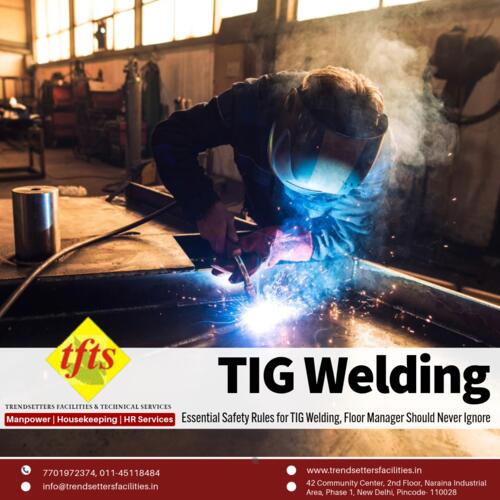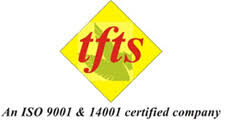
Welding operations are an integral part of many industrial and manufacturing setups. Among the various welding techniques, TIG (Tungsten Inert Gas) welding stands out for its precision and superior weld quality. However, this method also involves high temperatures, ultraviolet radiation, and hazardous gases that can pose serious safety risks if proper precautions are not maintained.
Therefore, it becomes the floor manager’s responsibility to ensure that every TIG welding activity adheres to strict safety protocols. Neglecting safety can result not only in injuries but also in costly downtime and damage to equipment explains TFTS which is India’s top TIG Welders supplier for SME and MSME sectors in India.
What is TIG Welding?
TIG welding, also known as Gas Tungsten Arc Welding (GTAW), is a process where a non-consumable tungsten electrode is used to produce the weld. The weld area is protected from atmospheric contamination by an inert shielding gas, usually argon or helium. This gas prevents oxidation and maintains a clean and stable arc describes Mr. Atul Mahajan, Director of Trendsetters Facilities and Technical Services.
Unlike other methods like MIG or stick welding, TIG welding gives the welder more control over the weld bead, making it ideal for thin materials and applications requiring high precision — such as aerospace, automotive, and stainless-steel fabrication. However, this high precision demands skilled handling and strict adherence to safety guidelines.
Why Safety Is Critical in TIG Welding?
TIG welding involves multiple hazards: high heat, electrical current, ultraviolet and infrared radiation, and exposure to harmful fumes. A single oversight can lead to burns, eye damage, respiratory issues, or even fires. Hence, safety measures must not be treated as optional but as a mandatory part of daily welding operations.
For a floor manager, enforcing safety standards means reducing workplace accidents, improving productivity, and ensuring compliance with industrial safety regulations standards.
Some Essential Safety Rules for TIG Welding
Mandatory Use of Personal Protective Equipment (PPE)
Every welder must wear proper protective gear:
Welding Helmet: Use an auto-darkening helmet with the correct shade to shield eyes from intense light and UV radiation.
Protective Clothing: Flame-resistant jackets, gloves, and aprons made of leather or heavy cotton protect the body from sparks and heat.
Safety Shoes: Insulated, steel-toe boots prevent electrical shock and injury from falling objects.
Respiratory Protection: In poorly ventilated areas, welders should use respirators to avoid inhaling harmful gases and metal fumes.
The floor manager must ensure PPE is checked regularly for wear and tear and replaced when necessary.
Maintain Proper Ventilation and Fume Extraction
TIG welding produces minimal fumes compared to other methods, but gases like ozone and nitrogen oxides can still accumulate in enclosed spaces. Adequate ventilation systems or local exhausts should be installed to keep the air clean. Managers should also ensure that air filters and ducts are cleaned regularly to maintain efficiency.
Electrical Safety Checks
Since TIG welding uses high voltage, electrical safety is critical:
- Inspect all cables and connectors for damage before each shift.
- Ensure that the work area and equipment are properly grounded.
- Keep welding machines away from water sources to prevent electric shocks.
- Only trained personnel should handle or repair electrical equipment.
Floor managers should maintain a checklist and ensure electricians or maintenance staff perform routine inspections.
Fire Prevention Measures
The high temperature of the welding arc can easily ignite nearby flammable materials. To prevent fire hazards:
- Keep the area free of paper, cloth, solvents, and oil.
- Provide fire extinguishers and sand buckets close to every welding station.
- Ensure fire alarms and sprinkler systems are functional.
- Conduct periodic fire drills so workers know emergency procedures.
A vigilant floor manager should designate a fire-safety officer for every shift, especially in high-risk areas.
Training and Skill Certification
Untrained or inexperienced welders are more prone to accidents. Every operator should undergo TIG welding certification and safety training covering equipment handling, emergency protocols, and first-aid measures. Refresher sessions should be organized regularly to keep everyone updated on new safety practices.
Equipment Maintenance and Calibration
Regular maintenance prevents malfunctioning machines from causing accidents or poor-quality welds. The floor manager should ensure:
- Welding torches, gas regulators, and hoses are inspected daily.
- Gas cylinders are stored upright and secured properly.
- Machines are calibrated periodically to ensure consistent current and voltage.
- Defective tools are tagged and removed from service immediately.
Clear Work Area and Signage
The welding zone should be kept clean and clutter-free. Proper safety signage — such as “Welding in Progress,” “Eye Protection Required,” or “Authorized Personnel Only” — must be placed to warn others of potential hazards. Barriers or welding curtains can protect nearby workers from arc flashes and sparks.
TIG welding delivers superior precision and clean welds, but its success relies heavily on a safe working environment. The floor manager plays a crucial role in enforcing these safety measures — from ensuring PPE compliance to maintaining equipment and ventilation. When safety is prioritized, it not only protects workers but also enhances productivity and the overall quality of work.
By following these essential safety rules, a floor manager ensures that TIG welding operations run smoothly, efficiently, and without incident — creating a workplace culture where safety and excellence go hand in hand.

Trendsetters Facilities & Technical Services (TFTS) is India’s leading manpower & temporary staffing agency for the manufacturing, power, hospitality, automobiles, IT, and Banking sectors. At present TFTS is the leading manpower supplier to Indian SEZs in SIDCUL, Rudrapur, Udhampur, Haridwar, and JAIPUR World. Some of the prestigious TFTS clients are Delhi Metro Rail Corporation, Bajaj Automobiles, Reliance Infrastructure, Haldirams, HCL.
Trendsetters Facilities & Technical Services (TFTS) offers a range of high-quality services from a team of specialized technicians for –
Life Maintenance and Repair
Housekeeping Services for Homes, Offices, Industries, and Institutions.
HR Outsourcing
Payroll outsourcing services
ITI Certified CNC Operators
Certified TIG welders,
Marble polishing services,
Fire hydrant system maintenance and more.
To Get Quotes
Call Us at : 7701972374, 011-45118484
Email: info@trendsettersfacilities.in
